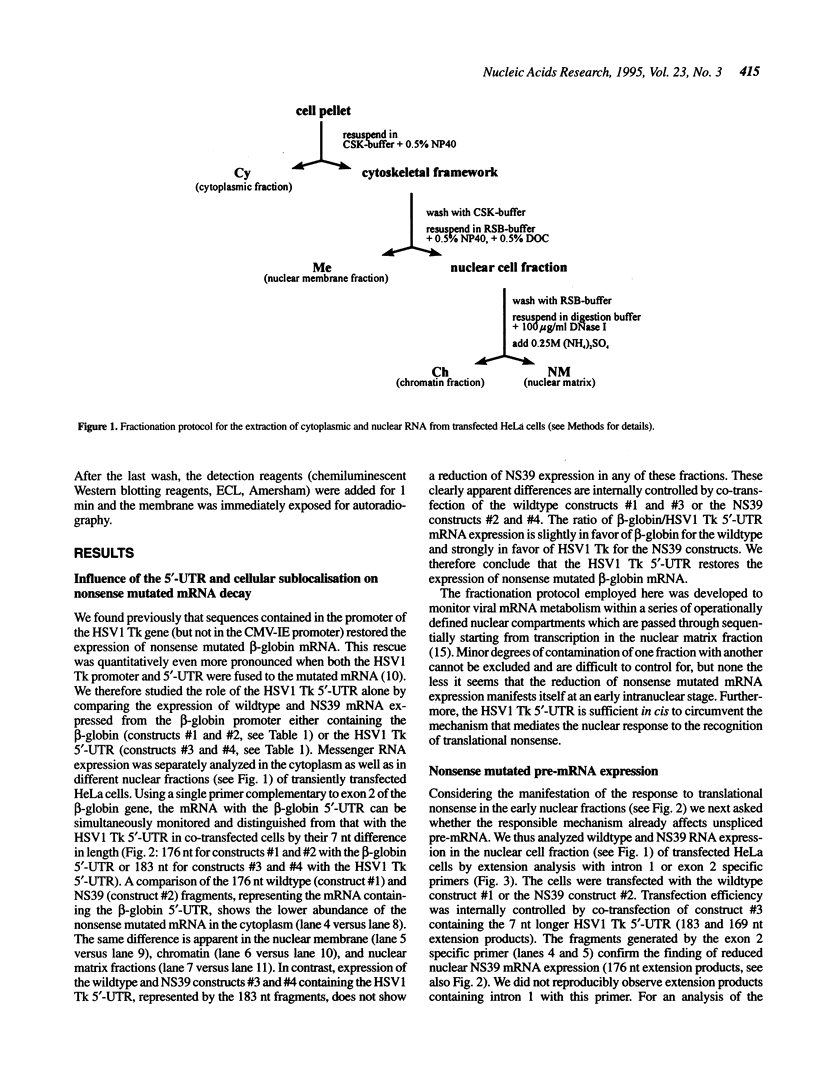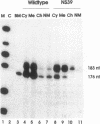Abstract
Nonsense mutations of the beta-globin gene are a common cause of beta-thalassemia. It is a hallmark of these mutations not only to cause a lack of protein synthesis but also a reduction of mRNA expression. Both the pathophysiologic significance and the underlying mechanisms for this surprising phenomenon have so far remained enigmatic. We report that the reduction of the fully spliced mutant beta-globin mRNA already manifests itself within the nucleus. In contrast, the levels of mutant pre-mRNA are normal. The promoter and the 5'-untranslated region (5'-UTR) of the herpes simplex virus type 1 thymidine kinase (HSV1 Tk) gene can independently circumvent this recognition/response mechanism in cis and restore nonsense mutated beta-globin mRNA expression to normal levels. These two genetic elements can thus exert a dominant influence on the post-transcriptional control of nonsense mutated beta-globin gene expression. While wild-type mRNA levels are restored by fusion of the HSV1 Tk 5'-UTR to the nonsense mutated beta-globin reading frame, translation of a wildtype reading frame in such a hybrid is precluded. In contrast, the HSV1 Tk promoter appears to efficiently deliver the mRNA to the translational apparatus. The 5'-UTR and the promoter sequences therefore control the nuclear fate of nonsense mutated beta-globin mRNA by separable pathways. The nuclear mRNA degradation mechanisms examined here may prevent the synthesis of C-terminally truncated beta-globin chain fragments and may protect heterozygotes from clinically relevant symptoms of beta-thalassemia.
Full text
PDF





Images in this article
Selected References
These references are in PubMed. This may not be the complete list of references from this article.
- Belgrader P., Cheng J., Maquat L. E. Evidence to implicate translation by ribosomes in the mechanism by which nonsense codons reduce the nuclear level of human triosephosphate isomerase mRNA. Proc Natl Acad Sci U S A. 1993 Jan 15;90(2):482–486. doi: 10.1073/pnas.90.2.482. [DOI] [PMC free article] [PubMed] [Google Scholar]
- Braddock M., Thorburn A. M., Chambers A., Elliott G. D., Anderson G. J., Kingsman A. J., Kingsman S. M. A nuclear translational block imposed by the HIV-1 U3 region is relieved by the Tat-TAR interaction. Cell. 1990 Sep 21;62(6):1123–1133. doi: 10.1016/0092-8674(90)90389-v. [DOI] [PubMed] [Google Scholar]
- Camaschella C., Bertero M. T., Serra A., Dall'Acqua M., Gasparini P., Trento M., Vettore L., Perona G., Saglio G., Mazza U. A benign form of thalassaemia intermedia may be determined by the interaction of triplicated alpha locus and heterozygous beta-thalassaemia. Br J Haematol. 1987 May;66(1):103–107. doi: 10.1111/j.1365-2141.1987.tb06897.x. [DOI] [PubMed] [Google Scholar]
- Campbell P. L., Kulozik A. E., Woodham J. P., Jones R. W. Induction by HMBA and DMSO of genes introduced into mouse erythroleukemia and other cell lines by transient transfection. Genes Dev. 1990 Jul;4(7):1252–1266. doi: 10.1101/gad.4.7.1252. [DOI] [PubMed] [Google Scholar]
- Chang J. C., Kan Y. W. beta 0 thalassemia, a nonsense mutation in man. Proc Natl Acad Sci U S A. 1979 Jun;76(6):2886–2889. doi: 10.1073/pnas.76.6.2886. [DOI] [PMC free article] [PubMed] [Google Scholar]
- Cheng J., Belgrader P., Zhou X., Maquat L. E. Introns are cis effectors of the nonsense-codon-mediated reduction in nuclear mRNA abundance. Mol Cell Biol. 1994 Sep;14(9):6317–6325. doi: 10.1128/mcb.14.9.6317. [DOI] [PMC free article] [PubMed] [Google Scholar]
- Cheng J., Maquat L. E. Nonsense codons can reduce the abundance of nuclear mRNA without affecting the abundance of pre-mRNA or the half-life of cytoplasmic mRNA. Mol Cell Biol. 1993 Mar;13(3):1892–1902. doi: 10.1128/mcb.13.3.1892. [DOI] [PMC free article] [PubMed] [Google Scholar]
- Cooper D. N. Human gene mutations affecting RNA processing and translation. Ann Med. 1993 Feb;25(1):11–17. doi: 10.3109/07853899309147851. [DOI] [PubMed] [Google Scholar]
- Enssle J., Kugler W., Hentze M. W., Kulozik A. E. Determination of mRNA fate by different RNA polymerase II promoters. Proc Natl Acad Sci U S A. 1993 Nov 1;90(21):10091–10095. doi: 10.1073/pnas.90.21.10091. [DOI] [PMC free article] [PubMed] [Google Scholar]
- Fey E. G., Krochmalnic G., Penman S. The nonchromatin substructures of the nucleus: the ribonucleoprotein (RNP)-containing and RNP-depleted matrices analyzed by sequential fractionation and resinless section electron microscopy. J Cell Biol. 1986 May;102(5):1654–1665. doi: 10.1083/jcb.102.5.1654. [DOI] [PMC free article] [PubMed] [Google Scholar]
- Forget B. G., Benz E. J., Jr, Skoultchi A., Baglioni C., Housman D. Absence of messenger RNA for beta globin chain in beta(0) thalassaemia. Nature. 1974 Feb 8;247(5440):379–381. doi: 10.1038/247379a0. [DOI] [PubMed] [Google Scholar]
- Hall G. W., Thein S. Nonsense codon mutations in the terminal exon of the beta-globin gene are not associated with a reduction in beta-mRNA accumulation: a mechanism for the phenotype of dominant beta-thalassemia. Blood. 1994 Apr 15;83(8):2031–2037. [PubMed] [Google Scholar]
- Hanash S. M., Rucknagel D. L. Proteolytic activity in erythrocyte precursors. Proc Natl Acad Sci U S A. 1978 Jul;75(7):3427–3431. doi: 10.1073/pnas.75.7.3427. [DOI] [PMC free article] [PubMed] [Google Scholar]
- Kazazian H. H., Jr, Dowling C. E., Hurwitz R. L., Coleman M., Stopeck A., Adams J. G., 3rd Dominant thalassemia-like phenotypes associated with mutations in exon 3 of the beta-globin gene. Blood. 1992 Jun 1;79(11):3014–3018. [PubMed] [Google Scholar]
- Kozak M. Point mutations define a sequence flanking the AUG initiator codon that modulates translation by eukaryotic ribosomes. Cell. 1986 Jan 31;44(2):283–292. doi: 10.1016/0092-8674(86)90762-2. [DOI] [PubMed] [Google Scholar]
- Kulozik A. E., Thein S. L., Wainscoat J. S., Gale R., Kay L. A., Wood J. K., Weatherall D. J., Huehns E. R. Thalassaemia intermedia: interaction of the triple alpha-globin gene arrangement and heterozygous beta-thalassaemia. Br J Haematol. 1987 May;66(1):109–112. doi: 10.1111/j.1365-2141.1987.tb06898.x. [DOI] [PubMed] [Google Scholar]
- Leppard K. N., Shenk T. The adenovirus E1B 55 kd protein influences mRNA transport via an intranuclear effect on RNA metabolism. EMBO J. 1989 Aug;8(8):2329–2336. doi: 10.1002/j.1460-2075.1989.tb08360.x. [DOI] [PMC free article] [PubMed] [Google Scholar]
- Lim S. K., Maquat L. E. Human beta-globin mRNAs that harbor a nonsense codon are degraded in murine erythroid tissues to intermediates lacking regions of exon I or exons I and II that have a cap-like structure at the 5' termini. EMBO J. 1992 Sep;11(9):3271–3278. doi: 10.1002/j.1460-2075.1992.tb05405.x. [DOI] [PMC free article] [PubMed] [Google Scholar]
- Lozano F., Maertzdorf B., Pannell R., Milstein C. Low cytoplasmic mRNA levels of immunoglobulin kappa light chain genes containing nonsense codons correlate with inefficient splicing. EMBO J. 1994 Oct 3;13(19):4617–4622. doi: 10.1002/j.1460-2075.1994.tb06783.x. [DOI] [PMC free article] [PubMed] [Google Scholar]
- Maquat L. E., Kinniburgh A. J. A beta zero-thalassemic beta-globin RNA that is labile in bone marrow cells is relatively stable in HeLa cells. Nucleic Acids Res. 1985 Apr 25;13(8):2855–2867. doi: 10.1093/nar/13.8.2855. [DOI] [PMC free article] [PubMed] [Google Scholar]
- Neuberger M. S., Williams G. T. The intron requirement for immunoglobulin gene expression is dependent upon the promoter. Nucleic Acids Res. 1988 Jul 25;16(14B):6713–6724. doi: 10.1093/nar/16.14.6713. [DOI] [PMC free article] [PubMed] [Google Scholar]
- Ramirez F., O'Donnell J. V., Marks P. A., Bank A., Musumeci S., Schilirò G., Pizzarelli G., Russo G., Luppis B., Gambino R. Abnormal or absent beta mRNA in betao Ferrara and gene deletion in delta beta thalassaemia. Nature. 1976 Oct 7;263(5577):471–475. doi: 10.1038/263471a0. [DOI] [PubMed] [Google Scholar]
- Sampietro M., Cazzola M., Cappellini M. D., Fiorelli G. The triplicated alpha-gene locus and heterozygous beta thalassaemia: a case of thalassaemia intermedia. Br J Haematol. 1983 Dec;55(4):709–710. doi: 10.1111/j.1365-2141.1983.tb02854.x. [DOI] [PubMed] [Google Scholar]
- Simpson S. B., Stoltzfus C. M. Frameshift mutations in the v-src gene of avian sarcoma virus act in cis to specifically reduce v-src mRNA levels. Mol Cell Biol. 1994 Mar;14(3):1835–1844. doi: 10.1128/mcb.14.3.1835. [DOI] [PMC free article] [PubMed] [Google Scholar]
- Thein S. L., Hesketh C., Taylor P., Temperley I. J., Hutchinson R. M., Old J. M., Wood W. G., Clegg J. B., Weatherall D. J. Molecular basis for dominantly inherited inclusion body beta-thalassemia. Proc Natl Acad Sci U S A. 1990 May;87(10):3924–3928. doi: 10.1073/pnas.87.10.3924. [DOI] [PMC free article] [PubMed] [Google Scholar]
- Urlaub G., Mitchell P. J., Ciudad C. J., Chasin L. A. Nonsense mutations in the dihydrofolate reductase gene affect RNA processing. Mol Cell Biol. 1989 Jul;9(7):2868–2880. doi: 10.1128/mcb.9.7.2868. [DOI] [PMC free article] [PubMed] [Google Scholar]
- Yu X. M., Gelembiuk G. W., Wang C. Y., Ryu W. S., Mertz J. E. Expression from herpesvirus promoters does not relieve the intron requirement for cytoplasmic accumulation of human beta-globin mRNA. Nucleic Acids Res. 1991 Dec;19(25):7231–7234. doi: 10.1093/nar/19.25.7231. [DOI] [PMC free article] [PubMed] [Google Scholar]
- de la Peña P., Zasloff M. Enhancement of mRNA nuclear transport by promoter elements. Cell. 1987 Aug 14;50(4):613–619. doi: 10.1016/0092-8674(87)90034-1. [DOI] [PubMed] [Google Scholar]





